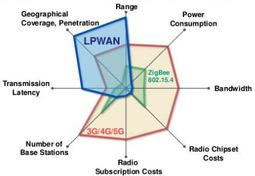NB-Fi: Benefits and Advantages of Narrowband IoT
Advertisement
This page covers the basics of NB-Fi technology and its features. It also outlines the key benefits and advantages of using NB-Fi.
Introduction
NB-Fi is a Low Power Wide Area Network (LPWAN) technology used for Internet of Things (IoT) and Machine-to-Machine (M2M) applications. Common LPWAN technologies include DASH7, Sigfox, LoRa, LTE-M, and Weightless. NB-Fi (Narrowband Fidelity) solutions are developed by WAVIoT TM, headquartered in Russia.
The technology is based on an open protocol and covers the full OSI model stack, from PHY and MAC layers to the application layer.
NB-Fi Network Architecture
The figure below illustrates the NB-Fi network architecture. The system comprises a Base Station (BS), end nodes, a cloud server, and other Network Management System (NMS) components for billing and network management.
Smart end nodes communicate with the BS using NB-Fi signals. The BS communicates with the cloud server via Ethernet, GPRS, or VSAT links.

Image courtesy: https://waviot.com/
Key Features of NB-Fi
The following are the major features of the NB-Fi wireless technology:
- Operating Frequency Range: 915 MHz, 868 MHz, and other sub-GHz licensed bands
- Coverage Range: 10 Km (City) to 30 Km (Countryside)
- Security: 256-bit key using XTEA-2
- Total Capacity: 20 x 10^5 nodes per BS (Base Station or Gateway)
- Channel Width: 100 Hz
- Modulation Scheme: DBPSK
- Typical Data Rate: 10 to 100 bps
- Topology: Full Duplex, Half Duplex (TDD)
Benefits and Advantages of NB-Fi
Here are the key benefits and advantages of using NB-Fi:
- Open Standard: Based on an open standard protocol, facilitating interoperability between various NB-Fi device manufacturers.
- Spectral Efficiency: Highly spectrally efficient, supporting a greater number of nodes per gateway or BS.
- Long Coverage Distance: Supports extended coverage distances.
- High Sensitivity: Highly sensitive, enabling data recovery from RF signals below the noise floor.
- Sub-GHz Operation: The use of sub-GHz frequency bands allows operation in complex channel scenarios.
- High Encryption: Offers a high level of encryption using a 256-bit key for end-to-end data transfer.
- AI Integration: Utilizes Artificial Intelligence (AI) and machine learning algorithms for self-management and other monitoring purposes, such as nearby co-channel RF energy measurements.
- Penetration: Offers a high level of signal penetration through concrete walls and basements.
- Long Lifespan: End nodes have a longer lifespan (approximately 10+ years).
- SDR Technology: Uses Software Defined Radio (SDR) technology, allowing for easy firmware downloads for radio configurations on the hardware.
Limitations of NB-Fi
While NB-Fi offers numerous advantages, there are some limitations or drawbacks to consider. Some of these include potentially lower data communication speeds and higher latency.
Conclusion
NB-Fi is considered ideal for long-range communication with a longer lifespan for the end nodes used in the NB-Fi network.
Advertisement
 RF
RF



